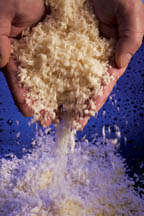

Japanese-style breadcrumbs allow food processors to market value-added products and new product concepts because the eating experience they invoke can be visually striking compared to more familiar products in the same category, such as American breadcrumbs (ABC) or Americanized Japanese breadcrumbs (AJBC). The latter ingredients have a flat texture.
The nama panko produced by Hydroblend Inc. (Nampa, Idaho) utilizes traditional Japanese technology, and has a great visual impact. “Your eye goes right to it. It stands up and talks to you,” says Henning Melvej, vice president of Hydroblend technical services. “It says, 'Hey take a look at me. Get a bite out of this.'”
The dough is set apart dramatically from AJBC because the spike level is so intense. The spike level is the height at which the crumb presents itself above the batter surface coating the product substrate. The spikes are created with electrostatic baking, a technique that creates heat with resistance by passing an electric current through the dough.
Nama panko is available in freshly frozen, semi-dry and dry formulas. Freshly frozen nama panko is resilient, so it holds up well during manufacturing. “Nama panko survives the freezing process beautifully,” states Bill Cyr, CEO of Hydroblend.
Freshly frozen and wet crumb nama panko (which has never been dried) are new to the U.S., and Hydroblend also offers Dried Panko, with 25%-30% of the moisture removed. “Some North American processors are more familiar with dried nama panko,” says Cyr. “The quality of nama panko far exceeds the quality of crumbs presently available in North America.”
Dried nama panko is shelf-stable and does not need to be frozen. It comes back to “life” upon reconstitution, and its appearance is unlike other dried breadcrumbs. Additionally, nama panko has excellent bake-back and fry-back qualities.
As it is done in Japan, Hydroblend's nama panko is baked from the inside out and, therefore, it is a solid white color because it does not develop a crust. The finished product turns a delicate golden color, but it does not have a brown or reddish tint (as do ABC bread crumb products). The electrostatically baked loaf is, in turn, shredded or pulled apart and sorted by screens according to size, but the intense bread flake edges are preserved.
Many breadcrumbs in the U.S. depend upon the crumb to provide crunchiness. The breadcrumb should complement the substrate, not overwhelm it. Unfortunately, some formulation methods place more taste emphasis on the crumb and not the substrate underneath. “Nama panko has a crisp sensation that blends with the substrate and batter but creates a harmony; not three different textures competing with each other,” adds Melvej. The versatility of nama panko makes it suitable for a number of applications, including beef, chicken, seafood, pork or cheesesticks.
The tender, flaky and sharp texture of nama panko also differentiates itself from ABC or AJBC because the flakes are much larger. “It melts away in the mouth, and you don't have to chew, chew, chew,” observes Melvej.
Although the ingredient declaration of Hydroblend's nama panko does not read that much differently from ABC, it is the processing, formulation and sourcing of higher-quality raw materials that makes it unique.
For more information:
Hydroblend Inc., Randy Hobert
972-517-5240
rhobert@hydroblendinc.com
www.hydroblendinc.com